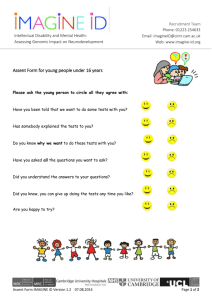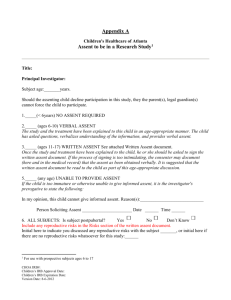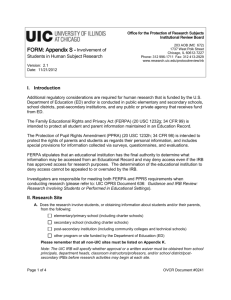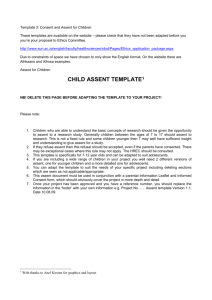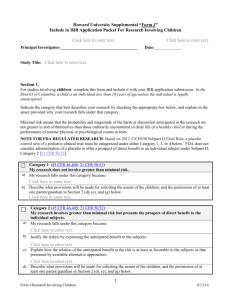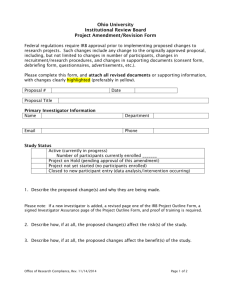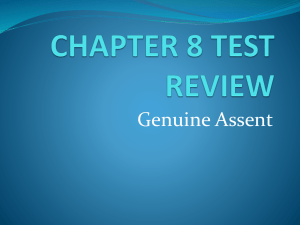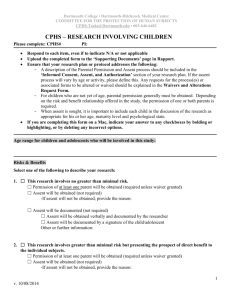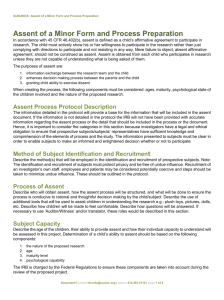Child Assent Policy - California Lutheran University
advertisement
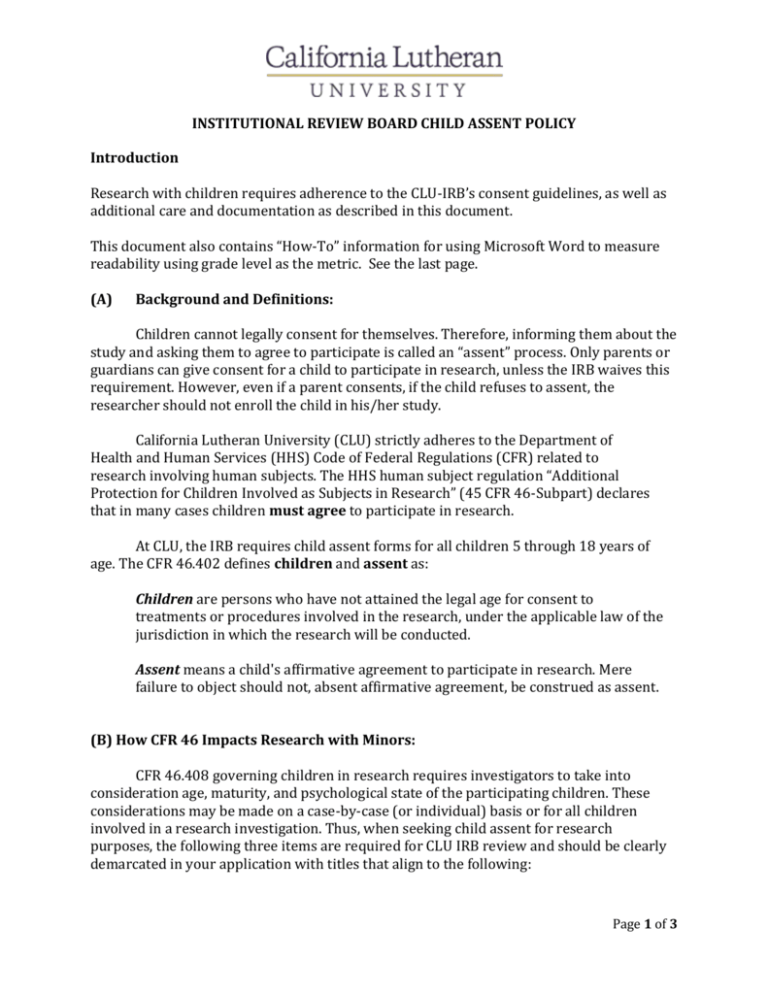
INSTITUTIONAL REVIEW BOARD CHILD ASSENT POLICY Introduction Research with children requires adherence to the CLU-IRB’s consent guidelines, as well as additional care and documentation as described in this document. This document also contains “How-To” information for using Microsoft Word to measure readability using grade level as the metric. See the last page. (A) Background and Definitions: Children cannot legally consent for themselves. Therefore, informing them about the study and asking them to agree to participate is called an “assent” process. Only parents or guardians can give consent for a child to participate in research, unless the IRB waives this requirement. However, even if a parent consents, if the child refuses to assent, the researcher should not enroll the child in his/her study. California Lutheran University (CLU) strictly adheres to the Department of Health and Human Services (HHS) Code of Federal Regulations (CFR) related to research involving human subjects. The HHS human subject regulation “Additional Protection for Children Involved as Subjects in Research” (45 CFR 46-Subpart) declares that in many cases children must agree to participate in research. At CLU, the IRB requires child assent forms for all children 5 through 18 years of age. The CFR 46.402 defines children and assent as: Children are persons who have not attained the legal age for consent to treatments or procedures involved in the research, under the applicable law of the jurisdiction in which the research will be conducted. Assent means a child's affirmative agreement to participate in research. Mere failure to object should not, absent affirmative agreement, be construed as assent. (B) How CFR 46 Impacts Research with Minors: CFR 46.408 governing children in research requires investigators to take into consideration age, maturity, and psychological state of the participating children. These considerations may be made on a case-by-case (or individual) basis or for all children involved in a research investigation. Thus, when seeking child assent for research purposes, the following three items are required for CLU IRB review and should be clearly demarcated in your application with titles that align to the following: Page 1 of 3 INSTITUTIONAL REVIEW BOARD CHILD ASSENT POLICY 1. A script that the investigator will read to all children describing their participation in said research project 2. A parental consent form 3. A child assent form. If the child is less than five years old, a verbal assent is typically adequate. Please note that parents/guardians should be contacted first or jointly with their children about research participation. A parental consent form must always accompany a child assent form in the CLU IRB application. This means that you may not submit a child assent form in an IRB application that does not also include a parental assent form. The CLU IRB finds that consent of one parent or guardian is sufficient. Please see additional details below about how to draft these three required items for IRB. Note that if a parent consents but the child refuses to assent the researcher should not enroll the child in his/her study. (C) For the purpose of your application, you must include the following: Please include the following details: a. Why the child is asked to participate. b. What is going to take place from the child's point of view. c. The risk to the child. d. The benefit to the child. e. Identification of the researcher by name and telephone number in case questions should arise. f. A statement that the child has a choice to participate or to withdraw at any time without negative consequences. Also, they can choose not to participate in parts of the study (e.g. they can chose not to answer certain questions in a questionnaire), but not withdraw from the study. g. A statement that the child will get a copy of the assent form. h. Date and signature lines for the researcher and for the child. (D) Drafting the Required Assent Items for IRB Research with children requires investigators to take into consideration age, maturity, and psychological state of the participating children. The first item is to write the script and assent form in language that is tailored to the emotional and educational level of the child. Short, simple sentences and friendly, conversational language is preferred. Page 2 of 3 INSTITUTIONAL REVIEW BOARD CHILD ASSENT POLICY Though exceptions can be made, CLU recognizes two particular age brackets: 5-11 and 1218. We recommend that research applicants employ language appropriate to these two particular sub-groups. In other words, a child assent form for a 5-year old may utilize different vocabulary and constructs, than that of an 18-year old. If your research population spans both sub-groups (e.g. 9 – 14 year olds), create one child assent form using language that can be understood by the youngest child. For very young children a verbal assent script that describes what will be said to the child may be more appropriate. It is also acceptable to not provide written assent procedures if the child is extremely young or not capable of understanding (parental consent will still be needed). However, we recommend that there is some tangible evidence that they agree to participate (e.g. circling a smiley face versus circling a frowny face). CLU-IRB requires that applicants check the reading level of their assent form using the Flesch-Kincaid grade level function in Microsoft Word. On a PC this is available in: File, Options, Proofing, “When correcting spelling and grammar in Word”, select “Show readability statistics”. See this link for PC information from Microsoft: https://support.office.com/enau/article/Test-your-document-s-readability-85b4969e-e80a-4777-8dd3-f7fc3c8b3fd2. On a Mac this is available in: Word, Preferences, Authoring and Proofing Tools, Spelling and Grammar, then select “Check grammar with spelling”, and select “Show readability statistics”. See this link for Mac information from Microsoft: https://grok.lsu.edu/article.aspx?articleid=7505. Minors and Internet-Based Research Researchers recruiting from the Internet cannot know the exact age of respondents. For this reason, it is best to limit online research studies to minimal risk adults unless you are able to authenticate the identity of your respondents through a reliable means. For more details or if you have questions, please contact IRB@callutheran.edu. Page 3 of 3
